 3 against a no-trump contract:
3 against a no-trump contract:CHAPTER 35
Signals in Defence
Tennis champion Martina Navratilova says that when Wimbledon was rained out she spent her time playing bridge to keep her sharp and on her toes.
Each defender tries to form a mental picture of the unseen hands when making his plan to defeat the contract. The defenders have many opportunities to help each other throughout the hand. We have already seen examples of how the defenders can pass information through the card that they lead. Leading the top of a sequence, for example, gives your partner information about more than the actual card played. It tells him something about the next higher card and the next lower card. Playing the lower of touching cards when playing third hand high can also give him information, as we saw in Chapter 32.
When you are playing to a trick that you are not going to win, you sometimes have a choice of cards to play. The specific card you choose can be used as a signal to your partner to give him some useful information about your hand. In this chapter, we will look at how you can use such signals to tell your partner your attitude towards a suit, how many cards you have in a suit and what you would like him to do next. Of course, signalling is a two-sided affair. Not only will you have to give the appropriate signal when an opportunity arises but you will also have to watch for the signals he gives you during the hand, so that you can form a better picture of the hidden cards and amend your plan accordingly.
Giving an attitude signal
One of the most useful pieces of information you can give a partner is whether or not you would like him to lead, or continue leading, a particular suit when he has the opportunity. This is referred to as an attitude signal. The principle is quite simple: a high card is an encouraging signal, a low card is a discouraging signal. Let’s look at an example where your partner has led the  3 against a no-trump contract:
3 against a no-trump contract:
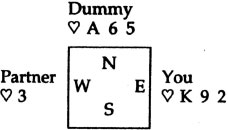
If the declarer were to play a low heart from the dummy, you would have no choice about what to play. You would have to play the  K, third hand high, in order to win the trick for your side. If the declarer plays the dummy’s
K, third hand high, in order to win the trick for your side. If the declarer plays the dummy’s  A on the first trick, however, you have a choice of cards to play. Since you like the suit your partner has led, you should play the
A on the first trick, however, you have a choice of cards to play. Since you like the suit your partner has led, you should play the  9, an encouraging card. If your partner regains the lead, he will know that you would like him to lead the suit again. Contrast the above layout with this one:
9, an encouraging card. If your partner regains the lead, he will know that you would like him to lead the suit again. Contrast the above layout with this one:
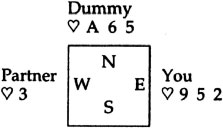
This time, you are not enamoured with your partner s lead so you would play the  2, a discouraging card, if the
2, a discouraging card, if the  A is played from the dummy. This will suggest to your partner that he find some other suit to lead at the next opportunity. Let’s look at some examples in complete hands. On the first, the auction has gone:
A is played from the dummy. This will suggest to your partner that he find some other suit to lead at the next opportunity. Let’s look at some examples in complete hands. On the first, the auction has gone:
|
North (Dummy) |
East (Partner) |
South (Declarer) |
West (You) |
|
Pass |
1 |
Pass |
|
|
3 |
Pass |
4 |
Pass |
|
Pass |
Pass |
Contract: 4
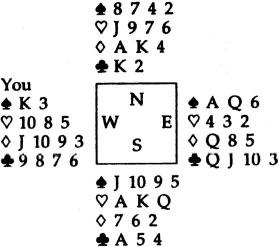
Against the declarer’s 4 contract, you start off by leading the
contract, you start off by leading the  J, top of your sequence, and the declarer wins the
J, top of your sequence, and the declarer wins the  K in dummy. The declarer then leads a small spade to his
K in dummy. The declarer then leads a small spade to his  J and you win with the
J and you win with the  K. What do you do now?
K. What do you do now?
Without the help of signals, this type of situation would be almost impossible for a defender. The opponents’ auction has not given you much information and anything might be right. Your partner may have the  A and
A and  K, and be hoping that you lead a heart, or he may have the
K, and be hoping that you lead a heart, or he may have the  A and
A and  Q and this is your last chance to trap the dummy’s
Q and this is your last chance to trap the dummy’s  K. Using attitude signals, however, makes the defence much easier. When the declarer wins the first trick with the
K. Using attitude signals, however, makes the defence much easier. When the declarer wins the first trick with the  K, your partner should play the
K, your partner should play the  8, an encouraging signal. Your partner, looking at the
8, an encouraging signal. Your partner, looking at the  Q, wants you to continue leading the suit to promote his
Q, wants you to continue leading the suit to promote his  Q as a winner. If you have watched his signal, you will lead another diamond to defeat the contract. The defence ends up with a diamond trick and three spade tricks.
Q as a winner. If you have watched his signal, you will lead another diamond to defeat the contract. The defence ends up with a diamond trick and three spade tricks.
It does the declarer no good to try to discard his diamond loser on the dummy’s extra heart winner before the trumps are drawn, since you will be able to ruff the dummy’s  J. If you had not continued diamonds, however, the declarer would have been able to draw your small trump and then discard his diamond loser, making the contract.
J. If you had not continued diamonds, however, the declarer would have been able to draw your small trump and then discard his diamond loser, making the contract.
You can sometimes use attitude signals to help get a ruff on defence. This time, we will put you in the East seat after the auction has gone:
|
North (Dummy) |
East (You) |
South (Declarer) |
West (Partner) |
|
1 |
Pass |
||
|
3 |
Pass |
4 |
Pass |
|
Pass |
Pass |
Your partner starts off by leading the  A, top of his touching high cards and here is the complete hand:
A, top of his touching high cards and here is the complete hand:
Contract: 4
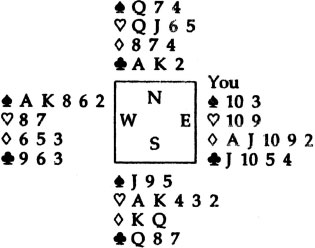
Which card do you play on the first trick? Again, this is an opportunity to use an attitude signal. Although you do not have a high card in the suit, you do have a shortness and would like your partner to continue leading the suit and give you a ruff. Your  A will then be enough to defeat the contract. To encourage your partner to continue, you must play the
A will then be enough to defeat the contract. To encourage your partner to continue, you must play the  10, not the
10, not the  3. If you play the
3. If you play the  3, a discouraging signal, your partner will not lead the suit again, being afraid to establish the
3, a discouraging signal, your partner will not lead the suit again, being afraid to establish the  Q in the dummy as a winner.
Q in the dummy as a winner.
Playing the  10 gives your partner the clue he needs about what to do next. He will realize that you must be encouraging him to continue leading the suit because you can trump the third round and so will continue by leading the
10 gives your partner the clue he needs about what to do next. He will realize that you must be encouraging him to continue leading the suit because you can trump the third round and so will continue by leading the  K and another spade. You ruff this, take your
K and another spade. You ruff this, take your  A and can now congratulate each other on your fine defence.
A and can now congratulate each other on your fine defence.
Let’s look at one more example. This time, the auction goes:
|
North (Dummy) |
East (Partner) |
South (Declarer) |
West (You) |
|
1 |
Pass |
2 |
Pass |
|
3 |
Pass |
Pass |
Pass |

You lead the  A, top of your touching high cards, and your partner plays the
A, top of your touching high cards, and your partner plays the  3 on the first trick. What now?
3 on the first trick. What now?
Your partner’s  3 is a discouraging signal, asking you not to continue leading the suit. What should you do instead? Neither hearts nor spades looks too appealing, so you try leading a small club. You are amply rewarded when this turns out to be the full hand:
3 is a discouraging signal, asking you not to continue leading the suit. What should you do instead? Neither hearts nor spades looks too appealing, so you try leading a small club. You are amply rewarded when this turns out to be the full hand:
Contract: 3
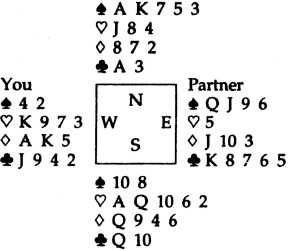
The club switch defeats the contract. When the declarer plays a low club from the dummy, your partner wins the trick with the  K and leads back the
K and leads back the  J to trap the declarer’s
J to trap the declarer’s  Q, In addition to your three diamond tricks and club trick, you eventually get a trick with the
Q, In addition to your three diamond tricks and club trick, you eventually get a trick with the  K. What if you had ignored your partner’s signal and continued by leading the
K. What if you had ignored your partner’s signal and continued by leading the  K? You would have established the declarer’s
K? You would have established the declarer’s  Q as a trick and the declarer would make the contract.
Q as a trick and the declarer would make the contract.
Giving a count signal
Sometimes, it will be clear to your partner whether or not you like a suit. In these situations, it is usually more important to tell him how many cards you have in the suit. This is referred to as giving a count signal. The method for giving a count signal is quite simple: a high card followed by a low card shows an even number of cards; a low card followed by a high card shows an odd number of cards.
Of course, it is not quite so straightforward in practice. You need to recognize the situations that call for a count signal rather than an attitude signal. If you play a low card, your partner needs to know whether this is a discouraging signal or the start of a count signal. Also, you will not always have the luxury of being able to play two cards in the suit before your partner has to make a decision. He may have to assume that the high card you played on the first trick is the start of a signal to show an even number of cards, or that the low card you played on the first trick is to show an odd number of cards. In addition, you may want to start a low-high signal to show an odd number of cards but your lowest card is a seven or an eight. You will have to do the best you can with the cards you were dealt.
It is easier to see how a count signal can be put to use by looking at a complete hand. One common situation in which it is used is when the declarer is trying to establish a long suit in the dummy and has no entry outside the suit. Here is an example:
Contract: 3NT

The opponents reach 3NT and your partner leads the  7. The declarer wins the first trick with the
7. The declarer wins the first trick with the  10 and goes about trying to promote the winners he needs to make the contract by leading a diamond. Look at what happens if you win the first or second diamond trick with the
10 and goes about trying to promote the winners he needs to make the contract by leading a diamond. Look at what happens if you win the first or second diamond trick with the  A. When you lead back your partner’s suit, the declarer plays the
A. When you lead back your partner’s suit, the declarer plays the  Q and your partner wins the
Q and your partner wins the  A and drives out the declarer’s
A and drives out the declarer’s  K to establish two more winners in the suit. But it does no good. On winning the
K to establish two more winners in the suit. But it does no good. On winning the  K, the declarer still has a diamond left to lead to the dummy’s winners. He ends up taking two spade tricks, two heart tricks, four diamond tricks and a club trick to make the contract.
K, the declarer still has a diamond left to lead to the dummy’s winners. He ends up taking two spade tricks, two heart tricks, four diamond tricks and a club trick to make the contract.
How could you have prevented this? Because the declarer started with three diamonds, you cannot afford to win the  A on the first or second round. You must wait until the third round. The dummy’s diamond winners are now stranded. Try as he might, the declarer cannot get to them and he ends up with only two diamond tricks instead of four. This is called a hold-up play and the declarer often uses the same technique to try to strand the defenders’ winners.
A on the first or second round. You must wait until the third round. The dummy’s diamond winners are now stranded. Try as he might, the declarer cannot get to them and he ends up with only two diamond tricks instead of four. This is called a hold-up play and the declarer often uses the same technique to try to strand the defenders’ winners.
How are you to know that the declarer started with three diamonds? After all, if he only had two diamonds, you could win the second trick and the dummy’s diamonds would be stranded. You could restrict the declarer to one trick in the suit. The answer, of course, is to make use of a count signal. When the declarer starts leading diamonds, it is obvious to both you and your partner that you are not interested in attitude towards the diamond suit – neither of you likes it. Instead, your partner can give a count signal by playing the  9 on the first trick and the
9 on the first trick and the  2 on the second trick, high-low to show an even number. Since the declarer has shown up with a couple of diamonds, you know that your partner has two, rather than four, and that leaves the declarer with exactly three. This lets you know that you must hold up your
2 on the second trick, high-low to show an even number. Since the declarer has shown up with a couple of diamonds, you know that your partner has two, rather than four, and that leaves the declarer with exactly three. This lets you know that you must hold up your  A until the third round of the suit. Had your partner played low-high in diamonds, to show three, you would have been able to win the second diamond trick in the knowledge that the declarer started with only two diamonds.
A until the third round of the suit. Had your partner played low-high in diamonds, to show three, you would have been able to win the second diamond trick in the knowledge that the declarer started with only two diamonds.
Giving a suit preference signal
The third type of signal that the defenders can use is a suit preference signal. This arises when you want to tell your partner which of two suits you would prefer him to lead, while you are playing a card in a third suit. The opportunity for this type of signal does not arise very often. It is only used when you clearly do not want to give an attitude signal or a count signal and when your partner is going to have to decide between one of two suits.
When the situation does arise, the basic principle is the following: a low card shows preference for the lower-ranking suit. As you can see, the situation for a suit preference signal must be very clear. Otherwise your partner will interpret a low card as a discouraging card or the start of a low-high count signal, and a high card as an encouraging card or the start of a high-low count signal. Nonetheless, a suit preference signal can be very useful when the opportunity arises.
Here is an example of the use of a suit preference signal when giving your partner a ruff:
Contract: 2

Against the opponents’ partscore contract of 2 , your partner decides to lead his singleton spade. You win the
, your partner decides to lead his singleton spade. You win the  K and
K and  A and, when your partner shows out, lead another spade for him to ruff. So far so good, but what does your partner do next? Should he lead a diamond or a club? Without suit preference signals, he would have no way of knowing what to do. If he leads a diamond, the declarer wins, draws the remaining trumps and eventually loses two club tricks, just making the contract.
A and, when your partner shows out, lead another spade for him to ruff. So far so good, but what does your partner do next? Should he lead a diamond or a club? Without suit preference signals, he would have no way of knowing what to do. If he leads a diamond, the declarer wins, draws the remaining trumps and eventually loses two club tricks, just making the contract.
This is a hand where the suit preference signal can be put to use. After playing the  A and
A and  K, you have a choice of leading the
K, you have a choice of leading the  10 or
10 or  2 for your partner to ruff. Since the spade you chose is clearly not useful as an attitude or count signal in the spade suit, it can be used to give a suit preference signal. Your partner is not going to be interested in leading back a heart, so his choice will be between diamonds and clubs. You would lead back the
2 for your partner to ruff. Since the spade you chose is clearly not useful as an attitude or count signal in the spade suit, it can be used to give a suit preference signal. Your partner is not going to be interested in leading back a heart, so his choice will be between diamonds and clubs. You would lead back the  2, your lowest spade, as a suit preference signal for the lower-ranking suit, clubs. When your partner ruffs this, he can use your signal to lead a club. The dummy’s
2, your lowest spade, as a suit preference signal for the lower-ranking suit, clubs. When your partner ruffs this, he can use your signal to lead a club. The dummy’s  K is trapped and you get two club tricks. You can then lead your remaining spade for your partner to ruff, defeating the contract. Had your clubs and diamonds been reversed, you would lead back the
K is trapped and you get two club tricks. You can then lead your remaining spade for your partner to ruff, defeating the contract. Had your clubs and diamonds been reversed, you would lead back the  10, your highest spade, as a suit preference signal for diamonds, the higher-ranking suit.
10, your highest spade, as a suit preference signal for diamonds, the higher-ranking suit.
Summary
When a defender has a choice of cards to play in a suit, he can use the card he plays as a signal to his partner. The three types of signal he can give are:
• Attitude signal – a high card is an encouraging signal; a low card is a discouraging signal.
• Count signal – a high card followed by a low card shows an even number of cards; a low card followed by a high card shows an odd number of cards.
• Suit preference signal – a high card shows preference for a higher-ranking suit; a low card shows preference for a lower-ranking suit.
Both defenders need to be aware of what type of signal the situation calls for. In general, an attitude signal takes preference, followed by a count signal and then a suit preference signal.
Over Zia’s shoulder
Hand 1 Dealer: South
|
North |
East |
South |
West (Zia) |
|
1 |
|||
|
2 |
Pass |
2NT |
Pass |
|
3NT |
Pass |
Pass |
Pass |

Against the opponents’ 3NT contract, I start with the  6, fourth highest of my long suit. The dummy’s
6, fourth highest of my long suit. The dummy’s  A wins the trick as my partner plays the
A wins the trick as my partner plays the  10 and the declarer the
10 and the declarer the  4. The declarer now goes about promoting some diamond winners by leading the
4. The declarer now goes about promoting some diamond winners by leading the  K, on which my partner plays the
K, on which my partner plays the  9 and the declarer the
9 and the declarer the  4.I hold up my
4.I hold up my  A on the first round, hoping to strand the dummy’s diamond winners, but I have to take it on the next round as my partner follows suit with the
A on the first round, hoping to strand the dummy’s diamond winners, but I have to take it on the next round as my partner follows suit with the  2 and the declarer with the
2 and the declarer with the  7. What do I do now?
7. What do I do now?
Solution to Hand 1:
Contract 3NT

|
S |
We need five tricks to defeat 3NT. |
|
T |
Initially, we only have the |
|
O |
Needing three more tricks, I will have to hope that my partner has either the My partner has given me the clue I need by playing the |
|
P |
In putting our final plan into operation, I must be careful, at this point, to lead a low heart to my partner’s |
As you see in the actual layout, leading a low heart after winning the  A is the only way to defeat the contract, it’s nice to have a partner who knows how to signal!
A is the only way to defeat the contract, it’s nice to have a partner who knows how to signal!
Hand 2 Dealer: East
|
North |
East (Zia) |
South |
West |
|
Pass |
1 |
1 |
|
|
2 |
Pass |
3NT |
Pass |
|
Pass |
Pass |
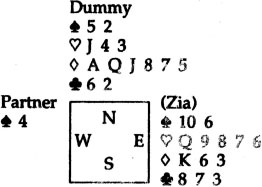
My partner leads the  4 against the 3NT contract and I play the
4 against the 3NT contract and I play the  10 on the first trick, third hand high. The declarer wins the trick with the
10 on the first trick, third hand high. The declarer wins the trick with the  Q and plays the
Q and plays the  10. My partner plays the
10. My partner plays the  9 and the declarer plays a small diamond from the dummy. What do I do now?
9 and the declarer plays a small diamond from the dummy. What do I do now?
Solution to Hand 2:
Contract 3NT
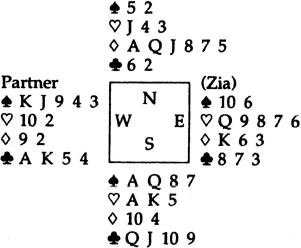
|
S |
Once again we need five tricks. |
|
T |
We don’t start with any sure tricks but, when the declarer takes the diamond finesse, we have an opportunity to get one trick with the |
|
O |
My general plan is to help my partner establish his spade tricks and hope that he has an entry so that he can take them. It looks as if we should win the |
|
P |
We let the declarer win the trick with the |